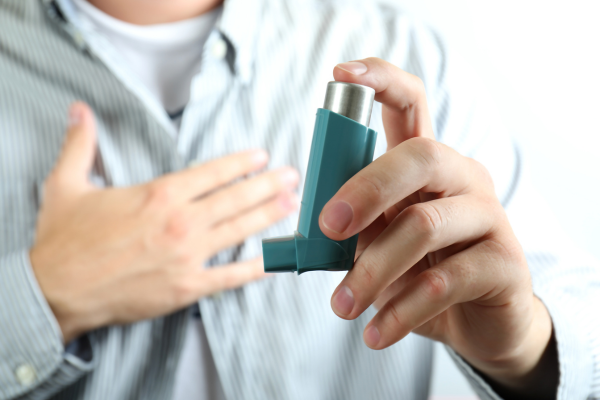Through the use of an inhaler, certain medications can be directly administered to the lungs. An inhaler is a small, handheld device used to deliver medication directly to the lungs. Types of inhaler devices include pressurized metered dose inhalers (MDIs or pMDIs), dry powder inhalers (DPIs), and soft mist inhalers.
Metered dose inhalers (MDIs or pMDIs)
MDIs deliver a precise dose of medication to the lungs. MDIs consist of a pressurized canister with a mouthpiece, which releases a mist when pressed. The technique used with MDIs affects how much medicine gets to the lungs. Your doctor can recommend the best technique based on your prescribed medicine. Inhaling correctly improves medication effectiveness. A spacer, a tube-like gadget, aids in better delivery, especially for kids or those with difficulty breathing.
Using an MDI without a spacer
When using MDIs without a spacer, don’t put the inhaler directly in your mouth unless your healthcare provider instructs you to do so. This prevents the medication from ending up on your tongue and throat instead of reaching your lungs where it’s needed.
The following steps outline the best method to use an MDI:
1. Remove the cap from the inhaler.
2. Hold the inhaler with the mouthpiece at the bottom.
3. Shake the inhaler — this mixes the medication properly.
4. Hold the mouthpiece 1-1/2 to 2 inches (2 – 3 finger widths) in front of your mouth. This improves medication delivery by slowing mist delivery and only allowing small particles to be inhaled. (Figure A). Note that some products are best used by placing the inhaler in your mouth. (Figure C), and you should check product instructions for your type and also consult your healthcare provider.
5. Gently breathe out.
6. Tilt your head back slightly and open your mouth wide.
7. Press the inhaler and at the same time begin a slow, deep breath.
8. Continue to breathe in slowly and deeply over 3 – 5 seconds; breathing slowly delivers the medication deeply into the airways.
9. Hold your breath for up to 10 seconds; this allows the medication time to deposit in the airways.
10. Resume normal breathing.
11. Repeat steps 3 – 10 when more than one puff is prescribed.
Note: MDIs should not be left in conditions of extreme heat or cold as this can impair their function.
KEY LEARNING: It is important to keep your inhaler clean. Some products support using a wet cotton swab to clean the opening. Follow the instructions in your product packaging and check with your healthcare provider for more specifics.
Using an MDI with a spacer
An MDI releases medication quickly due to pressure, making it hard to inhale the particles properly. Using a spacer (Figure B) suspends these particles until you breath in, making it easier to get the medication into the lungs. How well the medication reaches the lungs depends on its formulation, the type of inhaler, the patient’s breathing technique, and the structure of the airways. Fine particles in low-velocity aerosols can carry drugs deeper into the lungs. Side effects from inhalers often occur when the mouth traps large medication particles.
Here is why a spacer is recommended:
- Larger particles of the drug are trapped in the spacer itself (not in your mouth).
- The fine mist is inhaled deeper into the small airways.
- The risk for potential side effects is decreased.
- You do not have to coordinate the timing of the activation of an MDI with your breathing.
Each spacer comes with specific instructions for use and cleaning. Keep the spacer clean and dry because standing water can allow bacteria to grow, which might be inhaled into your lungs. Make sure the spacer dries properly after each cleaning.
VIDEO – How to use a Metered-Dose Inhaler with a Spacer
Medical Animation Copyright © 2020 Nucleus Medical Media. All rights reserved.
Dry Powder Inhalers (DPIs)
This small device is like an MDI, but it has powdered medicine. Both are handheld and deliver a precise dose to the lungs. The advantage of a dry powder inhaler is that it activates when you breathe in, eliminating the need to coordinate activation while inhaling. Simply breathe in quickly to start the medication flow. Different styles and brands have varied instructions, so know the proper technique for the method you use and always consult your healthcare provider.
Slow Mist Inhalers
Another inhaler type produces a mist that comes out slowly from the inhaler device. It’s unlike an MDI because it administers medication at a slower pace. Soft mist inhalers, like Respimat®, transform liquid medicine into a fine mist. Breathe in the mist through your mouth to deliver the medicine to your lungs.
What’s the difference between an inhaler and a nebulizer?
Inhalers and nebulizers both deliver medicines that treat lung conditions. An inhaler is a handheld device that doesn’t need electricity and usually delivers dry powder or a spray, sometimes a soft mist. Nebulizers are larger, powered by a battery or plug, and used with a mask or mouthpiece. They deliver medicine gradually over several minutes instead of in one breath.
Nebulizers deliver medicines in a fine spray or mist. Your doctor might recommend a nebulizer if:
- The medicine you need is only available as a liquid.
- It’s hard for you to use an inhaler correctly.
- You just prefer the nebulizer over inhalers.
No matter which device you use, the medicines will have the same positive effects. Make your choice based on what your health insurance covers and what your healthcare provider advises.
Sources:
https://subscriber.alphanet.org/s/article/6-4-3-proper-use-of-inhalers
https://my.clevelandclinic.org/health/treatments/8694-inhalers
